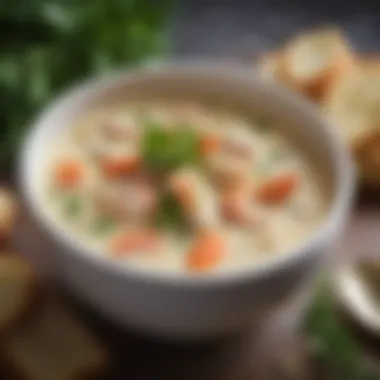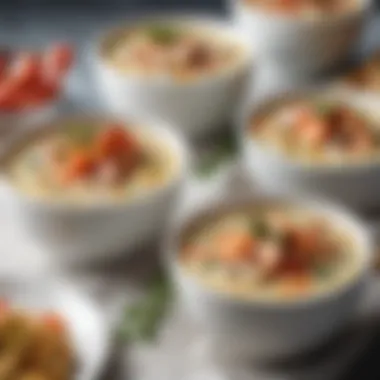A Comprehensive Guide to Seafood Chowder


Intro
Seafood chowder represents a hearty dish that carries warmth and flavor within its creamy depths. It has evolved over time, drawing from various regional cuisines and the availability of ingredients across different coastal areas. For food lovers, it transcends being just a meal; it embodies nostalgia and comfort, bringing family and friends together around the dining table.
Understanding seafood chowder involves recognizing not just the ingredients used but also the techniques that elevate it to perfection. Readers will find this guide detailed and informative. It is designed for both novice and experienced cooks. Here, we explore the fundamentals, allowing anyone to craft a well-balanced chowder.
Recipe Overview
Recipe Name
One can’t mention seafood chowder without referring to New England Clam Chowder, which serves as a hallmark of this culinary delight. Yet, there are many other variations that deserve attention.
Description of the Dish
Seafood chowder showcases a rich blend of fresh seafood, creamy broth, and aromatic vegetables. It typically features clams, shrimp, or fish, providing a spectrum of flavors. The soup possesses a unique texture, often thickened with flour or corn starch. Traditional versions highlight the balance of flavors, with a satisfying umami that accompanies each spoonful.
The dish varies widely across regions, reflecting local traditions and flavors. From the creamy base found in New England recipes to the tomato-based versions popular in the South, seafood chowder is adaptable, making it accessible for various palates.
Ingredients
List of Ingredients with Measurements
- 2 cups of fresh clams (shucked)
- 1 cup of diced potatoes
- 1 cup of corn kernels
- 1 medium onion, chopped
- 2 cloves of garlic, minced
- 4 cups of fish or seafood stock
- 2 cups of heavy cream
- 2 tablespoons of butter
- Salt and pepper to taste
- Fresh parsley for garnish
- Optional: 1 cup of diced fish (e.g., haddock or cod)
Special Notes on Ingredients
Choosing the right seafood is crucial. Fresh seafood yields the most flavor. If fresh clams are not available, canned clams can serve as a substitute but will alter the flavor profile slightly.
Potatoes can add heartiness, while corn enhances the sweetness. A mixture of dairy can also be employed; for instance, using half-and-half instead of heavy cream may lighten the dish without sacrificing richness.
For a more regional twist, consider incorporating local seafood such as crab or lobster. These ingredients can elevate an already flavorful dish to new heights. Each region has its specialty ingredients that can offer freshness and uniqueness in flavor.
Fresh ingredients are key to creating a vibrant chowder.
Every choice contributes to the overall experience of the dish. Knowing how to blend these elements effectively distinguishes a typical chowder from an exceptional one.
This guide will further elaborate on the techniques and variations that can enhance your seafood chowder, ensuring a comprehensive understanding of this cherished dish.
Preface to Seafood Chowder
Seafood chowder represents a culinary treasure that marries the richness of the ocean with the heartiness of traditional soup. It serves as a versatile dish, suitable for various occasions, from casual family dinners to elegant gatherings. Understanding seafood chowder is essential for anyone interested in expanding their culinary repertoire. It provides not only warmth and comfort but also an opportunity to showcase an array of ingredients.
The importance of this dish lies in its adaptability. Seafood chowder can be customized easily to suit personal preferences or regional traditions. This article is designed to unveil the intricacies of the dish, making it accessible to novice cooks, while also providing seasoned chefs with fresh insights and techniques.
"Mastering seafood chowder can elevate one's cooking skills significantly due to its reliance on balancing flavors and textures."
Defining Seafood Chowder
Seafood chowder generally refers to a creamy soup that incorporates various types of seafood, vegetables, and aromatics. It is a rich dish characterized by its velvety texture and depth of flavor. Chowders differ from broths or standard soups due to the inclusion of milk or cream, which creates a satisfying mouthfeel. Beyond mere sustenance, chowder can serve as a canvas for creativity, allowing cooks to experiment with different seafood and additional components.
Historical Background
The origins of seafood chowder are intertwined with maritime culture, particularly in coastal regions where fishing plays a vital role. Historically, chowder emerged from necessity, providing a way to utilize fresh catch. Traditional recipes often featured local seafood and were flavored with what was readily available, including potatoes, onions, and salt pork. The most noted types are New England and Manhattan, each boasting unique characteristics; New England chowder is creamy and rich, while Manhattan style features a tomato base.
Throughout the years, seafood chowder has evolved, gaining popularity beyond regional confines and becoming a staple in American cuisine. Today, it reflects a blend of influences, showcasing both classic and contemporary interpretations.
Core Ingredients
Core ingredients form the foundation of any seafood chowder. Understanding each component allows cooks to elevate the dish's flavor profile and nutritional value. Selecting the right ingredients is crucial to achieve balance and complexity in taste. In this section, we will explore the different types of seafood, vegetables and aromatics, as well as liquid bases, focusing on how each element contributes to the overall success of the chowder.
Types of Seafood
Fish
Fish is a primary ingredient in many seafood chowders. The delicate flavors of fish, like cod or haddock, greatly enhance the broth without overpowering other elements. Using fresh fish ensures that the chowder has a light, subtle palate. Cod, for example, is a common choice due to its flaky texture and mild taste. The key characteristic of fish is its ability to absorb flavors well, making it an excellent foundation for a seafood chowder.


However, overcooking can lead to a mushy texture. Ensuring proper cooking times is essential to maintaining the integrity of the fish.
Shellfish
Shellfish adds richness and a briny depth to chowders, making it a popular choice. Varieties like shrimp and clams infuse the chowder with a robust flavor. Shellfish are often revered for their unique texture, which can provide a satisfying contrast to the soup's smoothness. For instance, shrimp becomes tender while absorbing the surrounding flavors uniquely.
Nonetheless, shellfish can be an acquired taste for some. Proper handling is key to avoid any health risks, which can lessen their appeal.
Miscellaneous Seafood Options
Miscellaneous seafood options, such as squid and oysters, can introduce diverse flavors and textures to chowder. These ingredients not only enhance the complexity but can also make a chowder stand out. The unique cooking method for squid allows it to maintain a firm texture without becoming rubbery. Oysters, on the other hand, lend a creamy richness. Their distinct, ocean-like flavor can be delightful but may not suit every palate. It's essential to choose seafood that complements the overall dish harmoniously.
Vegetables and Aromatics
Onions
Onions are a must-have when preparing seafood chowder. Their versatility shines through in the dish, providing sweetness and a base for the overall flavor profile. Caramelizing onions before adding them to the chowder brings out their natural sugars, creating a deeper taste that enhances the entire dish. Their capability to meld with other ingredients while maintaining a discrete profile is valuable in achieving balance.
Overcooking can result in bitterness, so it is important to monitor this closely during preparation.
Celery
Celery contributes crunch and freshness to seafood chowder. It imparts a slight earthiness that can round out stronger flavors from seafood. This vegetable is low-calorie and adds fiber, making the chowder not only tasty but also nutritious. Moreover, its natural saltiness can sometimes reduce the need for added seasonings.
However, if not chopped finely, celery can become excessively fibrous, impacting the texture of the chowder negatively.
Carrots
Carrots add both sweetness and color, making the chowder visually appealing. Their natural sugars balance the briny ingredients well. Carrots are rich in vitamins, enhancing the dish’s nutritional profile. When simmered, they break down and integrate seamlessly into the broth.
Despite their advantages, over-cooking can lead to mushiness, which detracts from the overall texture of the chowder.
Liquid Bases
Fish Stock
Fish stock is foundational for a flavorful chowder. It enhances the seafood essence, providing a rich backdrop for the other ingredients. Using homemade fish stock can elevate the dish’s authenticity, as it captures the essence of fresh seafood. The depth of flavor from fish stock distinguishes a good chowder from a great one, allowing the ingredients to shine.
However, low-quality stock may lead to a diluted flavor, so sourcing high-quality ingredients is essential.
Clam Juice
Clam juice is another key component, ideally used in combination with fish stock. It brings an intense umami flavor that adds complexity. The marine notes of clam juice can bridge flavors, enhancing harmony within the chowder. It’s particularly effective in recipes that focus on the briny characteristic of the sea.
However, overuse can lead to an overpowering taste, masking the subtleties of other ingredients.
Cream and Milk Options
Cream and milk options create a silky texture that is comforting and rich. Options vary from heavy cream to lighter choices like half-and-half or even non-dairy alternatives. The choice of liquid impacts the richness and thickness of the chowder significantly. For a lighter option, using whole milk can still deliver a creamy mouthfeel without adding excessive calories.
Choosing the wrong option could lead to a watery or overly rich dish. Ensuring the right balance is imperative in creating the desired texture without overshadowing the seafood flavors.
Through careful selection and preparation of these core ingredients, cooks can craft a seafood chowder that reflects both tradition and personal style. As we delve deeper into preparation techniques, the emphasis on these ingredients' quality will remain crucial.
Preparation Techniques
Understanding preparation techniques is crucial for creating a delicious seafood chowder. These methods not only improve the flavor and texture but also ensure that the dish maintains its integrity. Mastering these techniques allows both novice cooks and experienced chefs to bring out the best in their ingredients.
Chopping and Slicing
Chopping and slicing is the first step in prepping seafood chowder. This process is essential for even cooking and proper incorporation of flavors. A uniform cut size helps in cooking all ingredients evenly. For example, vegetables like onions, celery, and carrots should be cut into similar sizes to avoid undercooked or overcooked pieces. Using a sharp knife is important as it provides cleaner cuts, minimizing the release of juices that can alter the taste of your chowder.
Cooking Methods
Cooking methods directly affect the final taste and texture of chowder. Each method serves a distinct purpose and introduces unique flavors.


Sautéing
Sautéing is a fundamental technique that involves cooking food quickly in a small amount of fat over moderate heat. This method enhances the flavors of the base ingredients, such as onions and garlic, creating a rich foundation for the chowder. The key characteristic of sautéing is its ability to caramelize the sugars in vegetables, adding depth to the overall dish.
One benefit of sautéing is the speed; it allows for quick preparation, keeping ingredients fresher. However, it is essential not to overcrowd the pan as it can lead to steaming instead of sautéing. This method is popular in preparing chowders because it lays the groundwork for essential flavors.
Simmering
Simmering is another vital technique for seafood chowder, providing a gentle heat that allows flavors to meld beautifully. Simmering occurs when liquid reaches a light boil and small bubbles begin to form. The meat of the seafood can become tender without overcooking, which is crucial for achieving the right texture.
The benefit of simmering is its ability to develop complex flavors over time. Ingredients such as fish stock and cream blend seamlessly during this process. However, care must be taken not to bring the chowder to a full boil, which could ruin the delicate seafood.
Thickening Techniques
Thickening techniques play a significant role in transforming chowder from a broth to a creamy dish. Several methods exist, including using flour, cornstarch, or even pureeing some of the vegetables. Each of these techniques contributes to the chowder's body and richness.
The characteristic of thickening is that it provides a more satisfying texture; diners expect a chowder to have a certain creaminess. A popular method is to create a roux—a mixture of equal parts flour and fat, cooked together briefly. However, too much thickening can overshadow the star ingredients, mainly the seafood, which might detract from the intended flavors.
Simmering and sautéing together result in balanced flavors essential for a successful chowder.
The Classic Seafood Chowder Recipe
A classic seafood chowder is not merely a dish; it serves as a symbol of comfort food for many. This section of the guide is vital as it combines the techniques and ingredients discussed previously into a cohesive recipe. It allows both novice cooks and experienced chefs to explore a fundamental aspect of seafood chowder that has stood the test of time. By providing an accessible yet authentic recipe, this section bridges the gap between basic cooking techniques and the refinement needed to create a rich, flavorful chowder that can impress anyone.
Ingredient List
When preparing seafood chowder, the choice of ingredients is crucial. A well-rounded ingredient list not only enhances flavor but also contributes to the dish's texture and nutritional value. Here are the main components:
- Seafood: The core of any seafood chowder. Common choices include cod, clams, shrimp, or scallops. Freshness matters greatly.
- Vegetables: Basic aromatic vegetables like onions, celery, and carrots infuse flavor. Diced potatoes can add substance.
- Liquid Base: A combination of fish stock or clam juice provides a savory foundation. Cream or milk adds richness.
- Herbs and Spices: Fresh thyme, bay leaves, and black pepper help in seasoning the chowder.
Step-by-Step Instructions
Creating seafood chowder involves several essential steps, each contributing to the final product's depth of flavor. Follow these detailed instructions:
- Prep the Ingredients: Start by washing, peeling, and cutting vegetables into uniform pieces.
- Sauté Aromatics: In a large pot, heat a tablespoon of butter over medium heat. Add diced onions and celery, cooking until soft and translucent, about 5 minutes.
- Add Vegetables: Introduce carrots and potatoes to the pot. Stir and allow them to cook for an additional 5 minutes.
- Incorporate the Liquid: Pour in fish stock or clam juice, and bring the mixture to a boil. Then, reduce to a simmer and add bay leaves and thyme.
- Cook the Seafood: After about 15 minutes, when the potatoes are tender, gently stir in your choice of seafood. Cook for approximately 10 more minutes, allowing the seafood to become opaque and tender.
- Finish with Cream: Slowly pour in heavy cream, stirring gently to combine. Allow it to heat through without boiling.
- Season to Taste: Remove bay leaves, season with black pepper, and adjust salt as needed before serving.
Serving Suggestions
When it comes to serving seafood chowder, presentation plays an essential role. Here are a few ideas:
- Bowls: Serve in individual bowls and garnish with fresh parsley or chives.
- Bread: Accompany with crusty sourdough or garlic bread for dipping. The bread can soak up the rich flavors of the chowder.
- Crackers: A side of oyster crackers enhances the experience with a satisfying crunch.
- Pairing: Wine such as a crisp Sauvignon Blanc or a light lager can complement the dish well without overpowering the flavors.
A well-crafted seafood chowder can evoke memories and comfort, making each bowl a delightful experience.
This recipe is a fundamental step into the world of seafood chowder. By mastering it, one gains a deeper appreciation for the dish and its various adaptations.
Nutritional Considerations
Understanding the nutritional aspects of seafood chowder is vital. This dish balances taste and health. As it combines various seafood, vegetables, and liquid bases, it offers multiple nutrients. These contribute to overall well-being. In this section, we will look closely at caloric content and the health benefits seafood provides.
Caloric Content
The caloric value of seafood chowder varies with recipes. On average, a one-cup serving can range from 250 to 350 calories. This number depends largely on factors like the type and amount of seafood used, the cream or milk base, and added ingredients.
Here are key points to keep in mind regarding caloric content:
- Seafood Contribution: Different types of seafood have distinct calorie counts. For instance, clams and shrimp are lower in calories compared to creamy bases which can elevate the total.
- Cream Versus Milk: Using heavy cream significantly increases the caloric intake compared to low-fat milk or broth-based alternatives.
- Serving Size: The portion size will also dictate the caloric content. Larger servings will naturally provide more calories.
Health Benefits of Seafood
Seafood offers many health benefits, making it a smart choice for seafood chowder. Incorporating fish and shellfish into your diet is known to be beneficial.
Some major health benefits include:
- Omega-3 Fatty Acids: Fish is rich in omega-3s. These fatty acids are linked to heart health. They also support brain function.
- Protein Source: Seafood is a great source of high-quality protein. It helps in muscle repair and growth.
- Low in Saturated Fats: Overall, fish tends to be lower in saturated fats compared to red meats. This can contribute to better heart health.
- Vitamins and Minerals: Seafood is a source of important vitamins, such as B12 and D. Additionally, it is rich in minerals like zinc and iodine.


The United States Department of Agriculture emphasizes that eating seafood twice a week can lower the risk of heart disease and promote overall health.
Variations of Seafood Chowder
Exploring the variations of seafood chowder is essential for understanding its rich diversity. Each version reflects unique regional flavors, cultural influences, and ingredient availability. This section highlights the importance of adjustment in recipes and cooking styles. It enriches the overall culinary experience and offers something for every palate. As cooks experiment with different textures and tastes, they create a broader appreciation for seafood chowder.
Regional Differences
New England vs. Manhattan Style
New England chowder is characterized by its creamy consistency, often made with milk or heavy cream. The addition of potatoes, along with clams or fish, forms a rich, hearty base that is comforting. The balance between the seafood and dairy creates an iconic flavor profile that many people associate with traditional chowder.
On the other hand, Manhattan chowder is tomato-based and lighter in texture. This variation includes similar seafood but leans heavily on vegetables like onions and bell peppers. The use of tomatoes introduces a tangy element that contrasts with the creaminess of New England chowder.
- Key Characteristic: The creamy richness of New England chowder versus the tomato base of Manhattan chowder.
- Benefits: New England chowder offers a classic, comforting taste, while Manhattan chowder introduces a lighter, refreshing alternative.
Pacific Northwest Influences
The Pacific Northwest brings its distinct flavors to seafood chowder. Fresh, sustainable seafood like salmon and shellfish are common in this variation. The use of local ingredients enhances the dish's appeal and freshness, showcasing the region’s natural bounty.
A unique feature here is the incorporation of local herbs, such as dill or chives, which elevate the dish's flavor further. Additionally, the chowder may include elements like corn or bacon, creating a rich combination that surprises and delights. This regional influence embraces an ethos of sustainability and freshness, making it a popular choice.
- Key Characteristic: The emphasis on local, fresh seafood and regional herbs.
- Benefits: Creative use of ingredients supports sustainability and offers an innovative twist to the traditional chowder.
Pacific Northwest influenced chowder thus provides an exciting variation that resonates with food lovers who appreciate local cuisine.
Vegetarian and Vegan Adaptations
Adapting seafood chowder for vegetarians and vegans enables a wider audience to enjoy this dish. By replacing seafood with hearty vegetables, beans, or even mushrooms, one can maintain depth in flavor while respecting dietary choices.
- Key Ingredients: Cauliflower, chickpeas, or tofu are notable substitutes that can emulate the texture often found in seafood.
- Flavor Enhancements: Vegetable stock can replace fish stock or clam juice, while non-dairy cream adds richness without compromising dietary needs.
This ability to adapt seafood chowder makes it versatile and inclusive. By doing so, cooks create an inviting atmosphere for all, regardless of dietary preference.
Cooking methods for these adaptations remain similar, preserving that comforting chowder essence while opening the door to culinary creativity.
Common Mistakes to Avoid
Understanding the common mistakes in making seafood chowder is essential. This knowledge empowers cooks to create a dish that is fullof flavor and texture. Proper techniques ensure that ingredients shine without being overshadowed by errors in cooking. Mistakes can lead to disappointing results, affecting both the taste and enjoyment of seafood chowder.
Overcooking Seafood
One of the most frequent errors in seafood chowder preparation is overcooking the seafood. Seafood, including fish and shellfish, can become tough and rubbery if subjected to prolonged cooking times. This not only alters the texture but also diminishes the natural flavors. To avoid this, it is crucial to add seafood at the right moment during cooking. Generally, it is best to introduce it towards the end of the cooking process, allowing it to cook gently in the residual heat of the chowder.
A few tips to prevent overcooking include:
- Use a timer to keep track of cooking times.
- Opt for high-quality, fresh seafood, as it tends to be more forgiving.
- Monitor the chowder closely, especially as it approaches doneness.
This careful approach ensures that the seafood maintains its integrity, resulting in a well-rounded chowder experience.
Incorrect Seasoning
Another substantial mistake in making seafood chowder lies in incorrect seasoning. Balancing flavors is key to a successful dish. Too little salt can result in a bland chowder, while too much can overwhelm the delicate taste of the seafood. Furthermore, relying solely on pre-made bases or stocks may lead to an imbalance of flavors.
To achieve optimal seasoning, consider these guidelines:
- Start with a small amount of salt and taste as you go.
- Use fresh herbs and spices to enhance the natural flavors of the seafood.
- Be aware that different types of seafood have varying salinity; for instance, clam or shrimp will impart additional saltiness.
End
The conclusion of this article captures the essence of seafood chowder, weaving together practical advice, knowledge, and the cultural significance embedded in every bowl. Seafood chowder is not merely a meal; it encompasses a spectrum of flavors and traditions from coastal kitchens to urban homes. This guide has emphasized the importance of understanding core ingredients, mastering preparation techniques, and recognizing regional variations. By doing so, enthusiasts can appreciate the nuances and elevate their culinary skills.
Key Takeaways
- Understand the Ingredients: The success of seafood chowder relies heavily on quality seafood, fresh vegetables, and suitable liquid bases. Choices should reflect both personal preference and regional availability.
- Master Cooking Techniques: Knowing how to sauté, simmer, and thicken will greatly impact the texture and depth of flavor in the chowder. Precision in cooking will prevent common errors, such as overcooking seafood.
- Adapt Varieties: Seafood chowder is versatile. Whether opting for a classic New England recipe or a daring vegan twist, experimentation can lead to delightful discoveries.
Final Thoughts on Making Seafood Chowder
Crafting seafood chowder is an exercise in both art and science. It involves balance—between flavors, textures, and even between tradition and innovation. As you embark on your chowder-making journey, remember to be patient and attentive. The process is just as important as the final result, and through careful preparation, you can unlock the dish's full potential.
In summary, seafood chowder can be a canvas for culinary creativity. With this guide, you now possess the tools and knowledge needed to create a delicious, personalized chowder that reflects your taste and experience. Dive into the world of seafood chowder with excitement and confidence.







